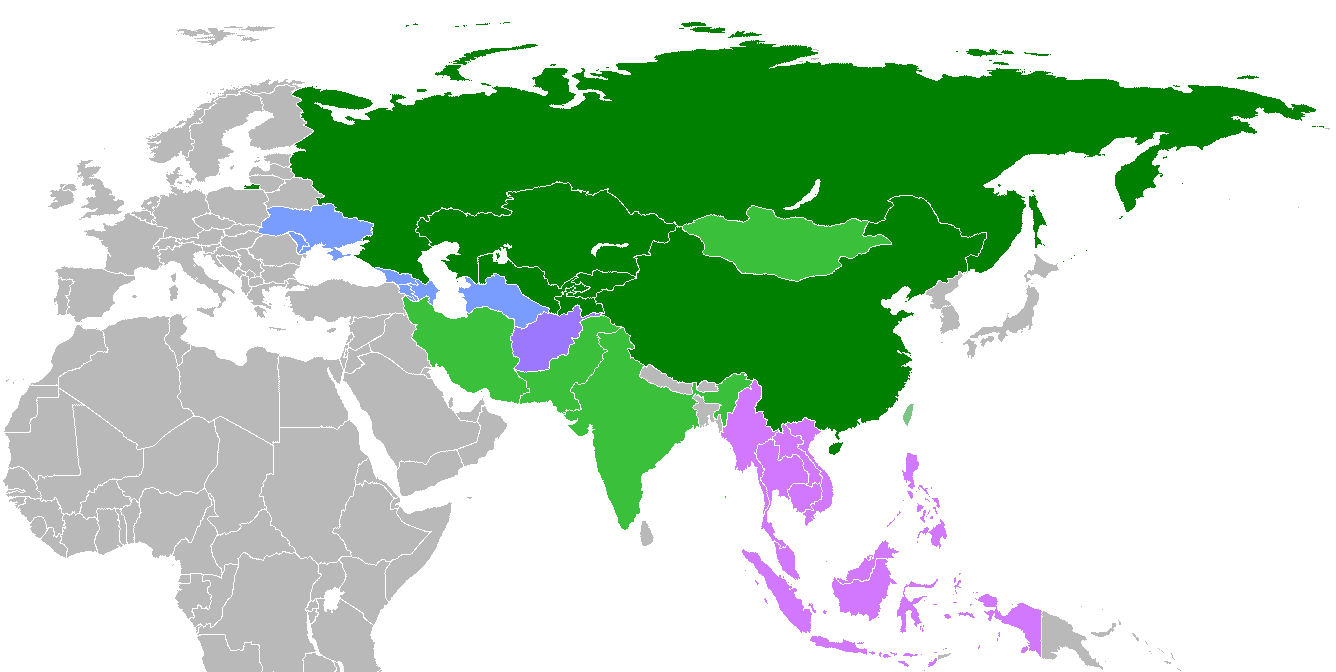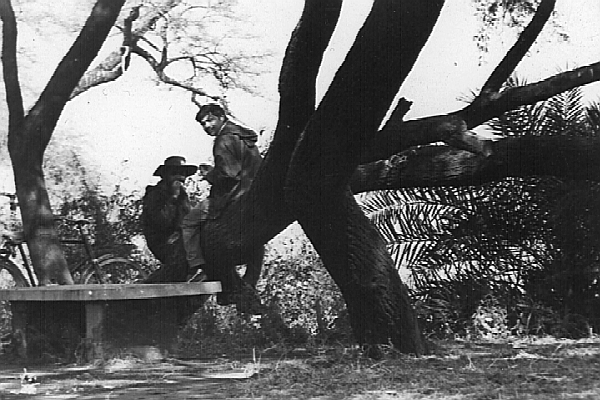I was told.
We are by the day becoming a strategic partner with the United States which is helping both our countries. So we want India to be a “Developed” nation by 2020 it is important that we get over this persecution mentality, recognize our importance and strength, be cogent in our rationale and most importantly start thinking big picture.
Yes, of course the big picture.
Perhaps believing I was incapable of such higher functions.
But by then, I had already started to see a different picture.
Like Robert Dreyfuss in July/August 2006
President Bush may or may not order a massive aerial bombardment of Iran later this year. Or he may wait until 2007. Or he may simply escalate a risky confrontation with Iran through covert action and economic sanctions. But whatever the next act in the crisis, don’t be fooled by the assertion that the problem is Iran’s pursuit of nuclear arms.
Iran is a decade away from gaining access to the bomb, according to the administration’s own National Intelligence Estimate, and despite all the talk about the ugliness of the theocratic regime in Tehran, the likely showdown is, at bottom, driven by the geopolitics of oil.
With one-tenth of the world’s petroleum reserves and one-sixth of its natural gas reserves, Iran sits in a strategic geographical position that makes it the cockpit for control of the entire Middle East.

It straddles the Persian Gulf’s choke points, including the Strait of Hormuz; it has important influence among Shiites throughout Iraq, Saudi Arabia, and the Gulf states; and it borders highly contested real estate to the north, from the Caucasus to the Caspian Sea to Central Asia.
The logic of the Bush administration is inexorable. Its ironclad syllogism is this: The United States is and must remain the world’s preeminent power, if need be by using its superior military might. One of the two powers with the ability to emerge as a rival—China—depends vitally on the Persian Gulf and Central Asia for its future supply of oil; the other—Russia—is heavily engaged in Iran, Central Asia, and the Caucasus region. Therefore, if the United States can secure a dominant position in the Gulf, it will have an enormous advantage over its potential challengers. Call it zero-sum geopolitics: Their loss is our gain.
A SUCCESSION OF U.S. presidents, from Franklin Roosevelt to Dwight Eisenhower to Jimmy Carter to George H.W. Bush, literally and figuratively planted the American flag at the heart of the Persian Gulf…Carter, in 1980, restated the doctrine even more forcefully: “Let our position be absolutely clear. An attempt by any outside force to gain control of the Persian Gulf region will be regarded as an assault on the vital interests of the United States.”
From the 1950s through the 1990s, the U.S. backed up those words with muscle. Iran, in particular, was always seen as the next step after Iraq. The original idea was that if the United States toppled Saddam Hussein and installed in Baghdad a regime dominated by Kurdish and Shiite puppets, Iran would be caught between U.S. forces to its west in Iraq and to its east in Afghanistan…
Not surprisingly, Russia and China have a different perspective. Moscow and Beijing, neither of which wants Iran to obtain nuclear weapons, nevertheless do not see Tehran as a threat. To them, the country’s vast reserves of oil and natural gas make it a natural ally. Both Russian and Chinese oil companies had enormous development and supply contracts with Baghdad under Saddam Hussein, deals that are worthless in an Iraq controlled by the United States. They might be forgiven for thinking that Iran, too, would be off-limits to them if Bush succeeds.
For China’s economic future, Iran and the region are essential. As recently as 1992, China was an oil-exporting country, but since then it has become a voracious importer of oil and gas…
In Iran, China has signed a series of gargantuan deals, including a 25-year contract reported to be worth $100 billion between Iran and the Chinese state-owned energy company Sinopec. China is also deeply engaged with Russia’s oil industry and with Central Asian oil exporters in constructing a web of gas and oil pipelines throughout the region.
President Vladimir Putin of Russia and President Hu Jintao of China have made energy the centerpiece of Russian-Chinese relations. Russia’s Rosneft oil company and China National Petroleum Co., two state-owned conglomerates, have negotiated plans for Russia to supply about 10 percent of China’s oil, and the Russian gas giant Gazprom is talking to China about building two huge new gas pipelines with a total capacity of 80 billion cubic meters a year. Last year, the Asia Times heralded the emergence of a strategic “new triangle comprised of China, Iran, and Russia.”
Since 2001, Russia and China have watched America’s heavy-handed push into the Middle East and Central Asia with suspicion and alarm.

Together, they and four Central Asian countries—Kazakhstan, Kyrgyzstan, Tajikistan, and Uzbekistan—have created the Shanghai Cooperation Organization (SCO), a regional security body that has emerged as a counterweight to U.S. influence in the region.
Last July, the organization issued a declaration demanding the withdrawal of U.S. troops from Central Asia; by the end of 2005, Uzbekistan had kicked the United States out of its Karshi-Khanabad air base, and soon Kyrgyzstan may evict the U.S. from its Manas air base, both head-on challenges to the administration in countries that Washington considers essential to its influence in Central Asia. This summer, the SCO may agree to extend a membership offer to Iran…
Flynt Leverett, who worked on Middle East policy for Bush’s National Security Council before resigning in disgust, told a political salon in Washington recently that the U.S.-Iran conflict could end up pushing Russia, China, and Iran closer together. “What I see as an emerging axis of oil between Russia and China will be greatly bolstered,” he said.
SERGEY LAVROV, Russia’s foreign minister, is Moscow’s point man for the U.N. talks about Iran. After a U.N. meeting in New York earlier this year, Lavrov said bluntly: “This looks like déjà vu.” Indeed, the parallels with the year before the invasion of Iraq are startling.
In addition to exaggerating the nuclear threat, the administration has been accusing Iran of harboring Al Qaeda fugitives and supporting bin Laden’s movement, though there is little or no evidence to support these claims.
As in Iraq, Washington is sinking millions of dollars into propaganda efforts and alliances with dubious exile groups; according to a recent State Department planning document, the United States is busily setting up Iran intelligence and mobilization centers in Dubai, Istanbul, Frankfurt, London, and Azerbaijan to work with “Iranian expatriate communities.”
Elizabeth Cheney, the daughter of the vice president and a top State Department official, is overseeing a program to spend $85 million on support for dissidents in Iran and to pay for anti-Iran propaganda. She has helped create a brand-new Office of Iranian Affairs at the State Department, and she reportedly supervises an office called the Iran-Syria Operations Group.
As with Iraq, U.S. officials—realizing that U.N. support for an attack on Iran is nil — are talking openly about bypassing the world body and forging yet another “coalition of the willing” to confront Iran.
And, of course, as with Iraq, there is the escalating rhetoric, the talk of “all options” being on the table, the news of Special Forces already operating in the country to foment civil conflict.
Tongue-dripping-with-anticipated-greed “willing”; for $$$ and resident status, perhaps?
The “willing”; like a “donkey” willing for the “carrot”.
As in The Henry Hyde’s Act,
SEC. 103. STATEMENTS OF POLICY. (b) WITH RESPECT TO SOUTH ASIA.—
(4) Secure India’s full and active participation in United States efforts to dissuade, isolate, and, if necessary, sanction and contain Iran for its efforts to acquire weapons of mass destruction, including a nuclear weapons capability and the capability to enrich uranium or reprocess nuclear fuel, and the means to deliver weapons of mass destruction.
The coalition of the “willing”, indeed.
On August 21 2007, a piece of document featured in small print in some webpages.
Understandings of The Islamic Republic of Iran and the IAEA
on the Modalities of Resolution of the Outstanding Issues Tehran –21 August 2007
IV General Consideraion:
4. The Agency has been able to verify the non-diversion of the declared nuclear materials at the enrichment facilities in Iran and has therefore concluded that it remains in peaceful use.
So Iran is not a nuclear threat after all.
Then should we still sign up to all the trash in the Hyde’s Act about Iran?
The media is starting to realise the picture is bigger and different after all.
And at last someone agrees, the 123 does not override the Hyde’s Act.
We have on September 5 2007,
…the official response to the various criticisms or doubts has been dismissive and disappointingly inadequate.
No one has bothered to sit down and explain that the various doubts and fears expressed were either incorrect or exaggerated. Instead, the response has been to depict criticism as a reflection of tunnel vision of cold war mindsets or nitpicking by ignoramuses.
In the midst of this emotional debate, it was forgotten that dissent is also a form of patriotism.
Protagonists of the deal have claimed that the 123 Agreement overrides the Hyde Act. This is incorrect because the 1954 Atomic Energy Act is the mother of all such Acts; the Hyde Act is a stringent enabling India-specific legislation for the 123 Agreement to be signed within the parameters of the Hyde Act…
As the U.S. readies for the battles of the 21st century, India must not ignore the resurgence of Russia, the rise of China and the relevance of Iran. It must manage its relations with all these powers. It needs to therefore pause and think about ways of smoothening the wrinkles in the nuclear deal.
If the sense of the House is that there are reservations about the deal then the party in power must address them adequately, in keeping with the convention that India’s foreign policy is pursued through consensus.
It should not be construed to be the handiwork of a tyranny of a minority in a minority.
In the meanwhile I can pray, can’t I?
 America
America India
India Iran
Iran Shanghai Cooperation Organisation
Shanghai Cooperation Organisation Hyde’s Act
Hyde’s Act












